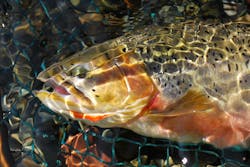Canadian coal company to pay $60M under Fisheries Act
Teck Coal Limited of Canada recently was ordered to pay a total of $60 million in fines and monetary court orders after a guilty plea was entered on two counts of unlawfully depositing a deleterious substance into water frequented by fish. In addition to the penalty, the company must also comply with a Fisheries Act Direction.
This sentence is the highest ever imposed by a court for pollution in violation of the Fisheries Act. Of the penalty, $58 million will be directed to the Government of Canada's Environmental Damages Fund and will be used to support projects that benefit Canada's natural environment. The remaining $2 million are fines that will be directed to the Receiver General.
The charges, laid on March 24, resulted from an investigation by Environment and Climate Change Canada, which revealed that Teck Coal Limited's operations were depositing deleterious coal mine waste rock leachate into the upper Fording River. In 2012, this leachate from Teck Coal Limited's Fording River Operations and Greenhills Operations coal mines deposited selenium and calcite into the upper Fording River.
During the investigation, under the authority of a warrant, enforcement officers captured Westslope Cutthroat Trout in the upper Fording River and some of its tributaries. Environment and Climate Change Canada's laboratory analysis determined that some of the fish captured contained selenium concentrations at levels that can be linked with adverse effects in fish. Officers also identified calcite deposits in the upper Fording River and some of its tributaries that had caused a hardening of the riverbeds that can affect the quality of the fish habitat.
Following the investigation, Environment and Climate Change Canada officers had reasonable grounds to believe that Teck Coal Limited had not taken all reasonable measures, consistent with public safety, and with the conservation and protection of fish and fish habitat as required by s. 38(6) of the Fisheries Act, and that immediate action was necessary to prevent and mitigate any detrimental effects.
Consequently, on Oct. 29, 2020, Environment and Climate Change Canada issued a direction. The measures required by the direction are aimed at preventing the discharge of deleterious substances and mitigating the adverse effects of selenium and calcite deposits to help protect the Westslope Cutthroat Trout population in the upper Fording River.
